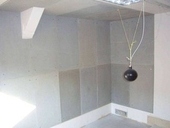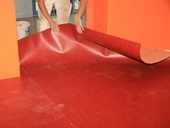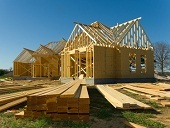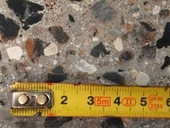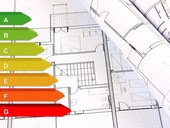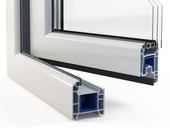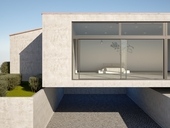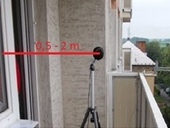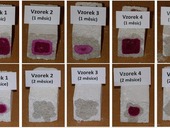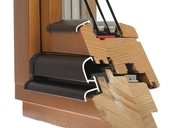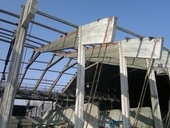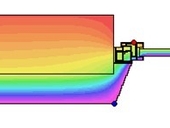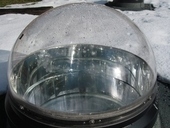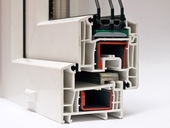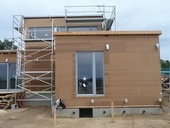The article describes the reasons for verification of moisture content of substrate layers and draws attention to illogicality of current approach, where moisture content in only very thin surface layer of 10 to 20 mm thickness is verified, but the influence of moisture held in entire thickness of the substrate layers is fully neglected. The article recommends use of in situ methods of measurement of dynamic moisture content of substrate layers, as it is for example described in American norms ASTM F1869-11 and ASTM D4263-83. Only moisture content measured by such methods, allows the contractors and investors to avoid many times fatal consequent failure of surface treatments.
Archiv článků od 30.9.2013 do 25.11.2013
The purpose of this paper is to inform about research and development results of special composite materials with enhanced capacity to accumulate infrared radiation. The aim of this project was to create an adjustment for wall and ceiling surfaces enabling good conduction, absorption and storage of thermal radiation with subsequent slow release of heat energy stored during periods of intermittently heating. This proposed solution in conjunction with infrared heaters and air conditioning equipment provides sufficient thermal comfort in heated spaces during winter season and thermal stability of rooms in summer. The main emphasis was on cost saving and increased efficiency of heating systems and cooling units.
The article presents one possible solution and principle for increasing absorption of infrared radiation and accumulative ability. The emissivity and surface temperatures of the developed sample were measured within the frame of the experimental works on real laboratory models in cooperation with specialists from Brno University of Techology (BUT) in Faculty of Mechanical Engineering (FME) and Faculty of Civil Engineering (FCI). The analysis of thermal comfort and energy balances including the assessment of the suitability in summer and winter was performed as well.
Condition survey process, or the process of gathering information and making passports, is one of the basic activities of asset management. In this article focus is on information retrieval and passports, which as an important tool for managing the assets recorded its technical condition and serves as a basis for further planning process, prolonging life and mainly benefit.
Recently, healthiness of the indoor space of buildings has been discussed more and more often. One of the points of view has been also presence of toxic substances, released into the indoor space from materials used for construction and design of the rooms, and from furniture. The most questionable materials include certain plastics, and, among them, especially polyvinyl chloride (PVC). Among other things, phthalates (used as plasticizers for PVC) may be released from this plastic. The Arnika Association commissioned analyses of 5 samples of floorings and 3 samples of wallpapers made of soft PVC. Phthalates were found in all the samples, in the range from 4.85 to 17.03 % of the product weight. In two of the samples, di-(2-ethylhexyl)phthalate (DEHP) was used as the plasticizer. DEHP will be banned in the European Union from 2015, together with 3 further phthalates. The remaining samples contained di-isononyl phthalate (DINP) and di-isodecyl phthalate (DIDP). These phthalates will not be banned, but they are also questionable from the point of view of health impacts. Four years ago, the Arnika Association took also samples of dust inside various buildings. Phthalates were found in all of them. The highest phthalate concentration was found in dust from a school dining room with flooring made of PVC. Presence of certain phthalates in dust is risky especially for young children. Phthalates are related to allergies (BBP, DEHP, and DINP) and asthma development (DEHP) in children.
The submitted paper primarily informs about specific fire requirements for wooden houses in the Czech Republic and, due to its total size, it is divided into two parts. The first part is focused on combustibility of building products, i.e. classes of reaction to fire, types of load-bearing and fire separating structural elements (DP1, DP2 and DP3), assessment of construction systems for buildings (incombustible, combustible, mixed) and fire resistance of wooden houses in total. The second part is consequently focused on the issue of space separation of external timber walls with various material arrangements that can noticeably limit location of wooden houses on building sites.
One of the options for the treatment of coal tailings is production a new kind of artificial aggregate on the self-burning principle. The aim of the work was to demonstrate the possibility of using this aggregate in concrete structures. Subject of the paper are not only the results obtained after 360 days of ripening, but also to compare them with the properties commonly manufactured concrete.
Thin-walled composites made of fine-grained cement-sand matrix reinforced by alkali-resistant glass fibres are currently used for the range of applications in the building industry, especially as architectural elements and cladding panels. Their advantage is mainly low weight as well as resistance to mechanical and weather impacts. These preconditions led to an innovative solution of cladding elements for accumulation and consecutive utilization of solar energy. Solar energy is transformed into heat energy by the means of an integrated pipe system and the heat achieved is deposited by the means of a heat water reservoir. Element surface can be set with photovoltaic cells. This material is possible to use as a roof panel as well. On the contrary to standard robust photovoltaic panels a difficult superstructure is not necessary and roof structure assembling is much easier. A wide range of simulation trials in interior as well as real tests in exterior was carried out with cooperation of a renowned company from the photovoltaic branch.
Article presents the results of expert authors work to address the critical situation associated with a negative opinion of the authority concerned czech KHS and impending ban trial operation structures associated with adverse acoustic impacts of construction traffic on the surrounding buildings object. Technical modifications and methods to prevent the reported results were described in Article Equivalent sound pressure level outside space in practice. Text contains the results of measuring the noise level around buildings and not just before and after the implementation of modifications to reduce the acoustic parameters, but also the results of control measurements on site and in the surrounding area. The purpose of this article is to assess the contribution made arrangements for acoustic comfort.
Application of the burning lime for masonry is known from the eldest ages. In history was empirically discovered, the properties of lime putties and mortars made from it can be modified adding various additives. Inorganic additives with latent hydraulic activity (natural pozzolana, thermal modified rocks) or organic additives (proteins, carbohydrates, organic acids as fruit juices etc.) were used. Beneficial influences of some additives were proven by contemporary science. Application of other additives seemed irrational from present point of view. The aim of this work was determined the influence of some historical additives on lime putties and mortar properties.
Paper will inform you about the results of a comparison of several hydrophobic additives. Building components based on plaster without special treatment generally have high water absorption (~ 30 %) and they are therefore not suitable for areas with high incidence of moisture, where they can be exposed to direct contact with water. The trend leads towards lighter building materials, which often leads to an increased proportion of open porosity and thus to increased absorption. A suitable solution is utilization of hydrophobic additive during the production of gypsum building elements. Appropriately chosen additive can significantly reduce water absorption, even at relatively low addition and high mass lightening of element.
The 70-ers and 80-bit of the last century were developed a number of standardized structural framing wood-based, which produced the then national wood processing plants. Several of these systems have been specifically developed for agriculture, in which wooden structures are preferably applied mainly for objects with increased aggressiveness environments such as. storage of fertilizers, stabling facilities etc. Some of these buildings still serve their original purpose even today, although their structures are weaknesses of different nature.
The weakest part of concrete high-rise block are their envelopes, so most of regenerations are dealing with reconstruction of existing envelopes. It related of the replacement of window openings, the installation of additional contact thermal insulation or modifications of projecting structures, including loggia glazing and, last but not least, changes in the colour shading of the surface façade layer. These adjustments can improve energy efficiency of the building, but secondary negative effects on the interior environment in terms of the daylight level must also be considered. In this study we tried to take account of both width and shape of jamb of the window with taking into account the effect daylight inside the room.
The paper is focused on hygrothermal performance of light pipes used in Kaprálův mlýn center. It is present an analysis the condensation risk in roof dome of light pipe and on surface of double insulated glass in cool part of light pipe. Insulated glazing is integrated to thermal insulation block made of extruded polystyrol.
This paper is the first part of the series about windows and doors on TZB-info. The series will be focused on all elements of windows and doors, their design and construction. We will highlight in detail the most important aspect for choosing new windows or doors. This first part is focused on windows and doors with plastic frame.
Timber-concrete composite structures which use advantages of both materials are suitable for new works and reconstructions of civil and residential buildings. There are described many methods of joining between timber beam and concrete slab in technical literature. Joints are more and more sophisticate which brings higher demands of work control and technology. Main goal of this paper is in design technologically low demanding method of joining with steel plates and nails, to test its shear strength and compare it with other similar joining method.
zpět na aktuální články

